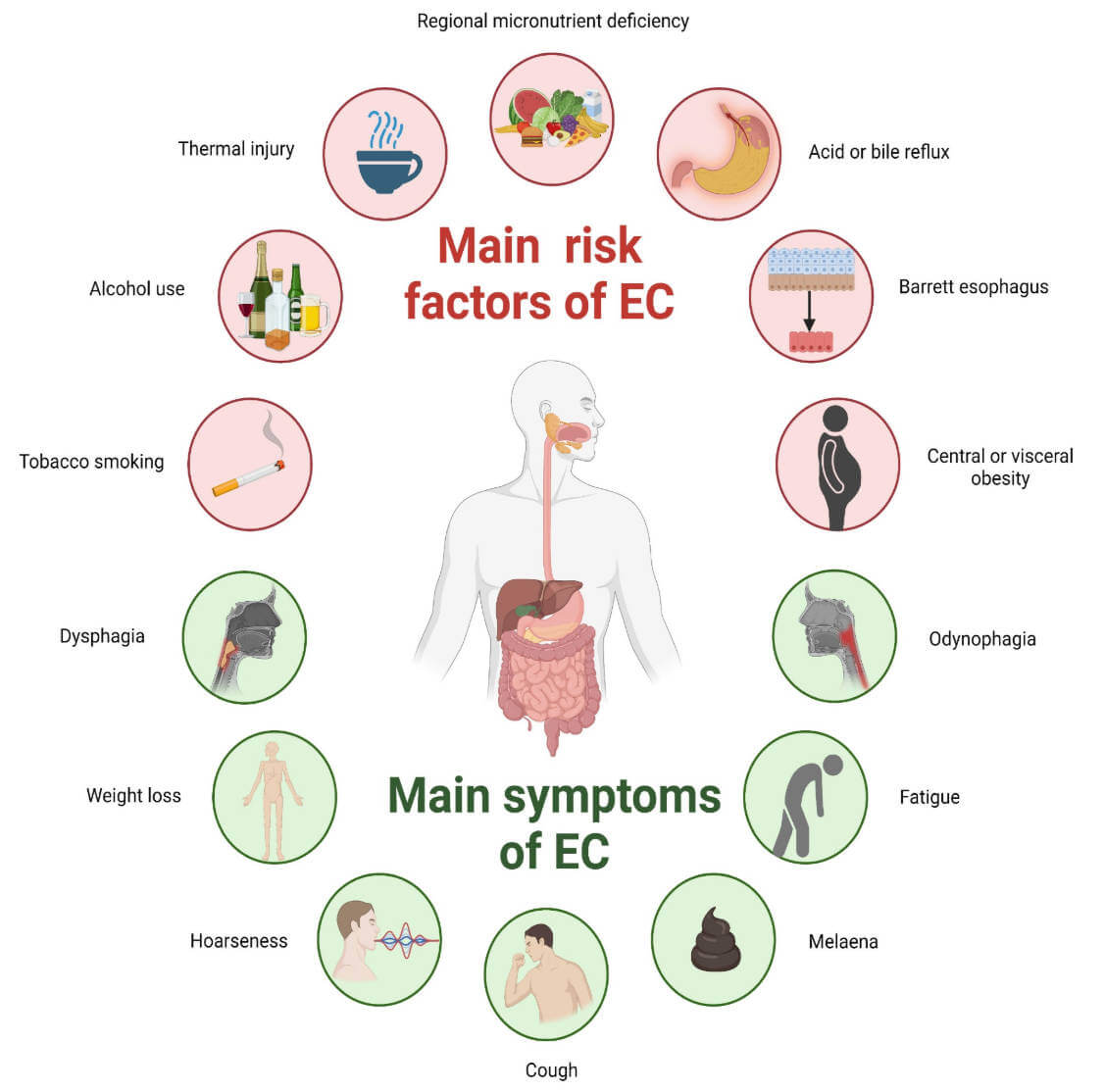Creative Biolabs is a leading CRO company specialized in antibody development. Based on our powerful technology platforms, we offer high-quality in vitro diagnostic (IVD) antibody development services targeting a wide range of biomarkers of different diseases. Here, we focus on esophageal cancer.
Esophagus is the food pipe that runs between the throat and the stomach. Esophageal cancer is cancer that started from the esophagus. The symptoms include swallowing difficulty, weight loss, pain, enlarged lymph nodes around the collarbone. It is considered a serious malignancy with respect to prognosis and mortality rate and accounts for approximately 400,000 deaths around the world in 2005. Esophageal carcinoma ranks the eighth most common cancer and the sixth most common cause of cancer-related deaths worldwide with developing countries making up approximately 83% of total cases and deaths. Moreover, esophageal cancer is expected to increase in incidence in the next 10 years.
 Fig.1 Main risk factors, symptoms of esophageal cancer.1
Fig.1 Main risk factors, symptoms of esophageal cancer.1
Type
There are two types of esophageal cancer which are squamous cell carcinoma (SCC) and adenocarcinoma. SCC arises from the flat cells lining the esophagus. The cancer is mostly found in the upper and middle part of the esophagus, but it can occur almost anywhere along the esophagus. SCC is the most common type of esophageal cancer on a global scale. The overall incidence increases with age, reaching a peak between 70 to 80 years of age. SCC occurs equally as often in the middle and lower esophagus, with an incidence that is three times higher in black people have more chance of catching esophageal cancer than white people. Adenocarcinoma starts in glandular cells which are found in tissues and make and release mucus and other fluids. In addition to esophageal cancer, most cancers of the breast, pancreas, lung, prostate are adenocarcinomas.
Risk Factor
- Alcohol Consumption and Tobacco Use
For esophageal cancer, the major risk factors are alcohol and tobacco. Most studies have revealed that alcohol is the primary risk factor. However, smoking in combination with alcohol consumption may have a synergistic effect and increase the relative risk. The relative risk in men who are both heavy smokers and drinkers is 35.4 in white males compared to men of the same race and region who don't use alcohol or tobacco. For black males, the relative risk is as high as 149.2. How tobacco and alcohol in combination lead to increased risk of esophageal cancer has been extensively studied. Detoxification is the physiological process that removes the toxic substances from a living organism, and this process mainly occurs in the liver. Alcohol can somehow damage the cellular DNA by decreasing metabolic activity within the cell and therefore reduce detoxification function while promoting oxidation. Meanwhile, alcohol is a solvent, specifically of fat-soluble compounds, making the hazardous carcinogens within tobacco penetrate the esophageal epithelium much easier.
- Nitrosamine
Found in certain salted vegetables and preserved fish, nitrosamine has also been found to be implicated in SCC. The mechanism of how this occurs is still studied. It appears to be associated with inflammation of the squamous epithelium that leads to dysplasia and in situ malignant change.
Diagnosis
The diagnostic evaluations of squamous cell carcinoma and adenocarcinoma are both important and identical. The first step in diagnosing esophageal cancer is double-contrast barium esophagography, which may involve the use of solid preparations and liquid barium for a more complete evaluation of dysphagia. Abnormal studies reveal filling defects or esophageal narrowing, and what should be done next is endoscopy and cytologic brushings of the involved area. When the suspicious symptoms and normal study results are present, endoscopy with biopsy and brushings of any questionable areas is indicated. It is noteworthy that multiple biopsies of suspicious lesions are required for accurate diagnosis, since visible tissue may just reveal inflammation. An upper gastrointestinal endoscopy also may be used in the initial evaluation of patients suspected of having esophageal pathology.
Creative Biolabs has accumulated extensive experience in antibody development. Supported by our powerful IVD platform, we are fully equipped to offer high-quality IVD antibody development and immunoassay development services to global clients. If you are interested in what we offer, please feel free to contact us for more details.
Our services target the following potential biomarkers for Esophageal cancer diagnosis:
Reference
- Zhang, Haowen, et al. "Unraveling the Complexity of Regulated Cell Death in Esophageal Cancer: from Underlying Mechanisms to Targeted Therapeutics." International Journal of Biological Sciences 19.12 (2023): 3831. Distributed under Open Access license CC BY 4.0, without modification.
For Research Use Only.

